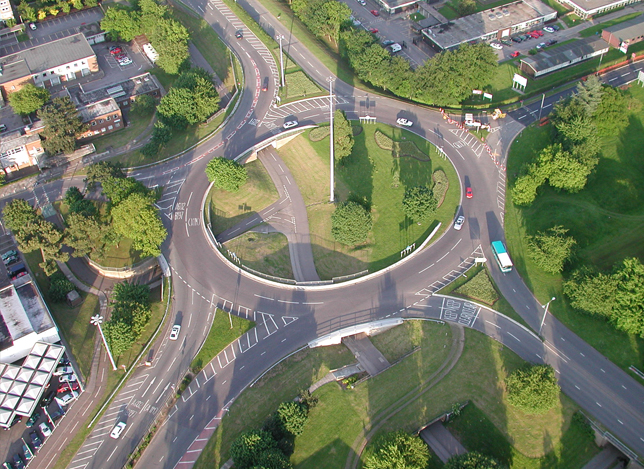Roundabouts are one way circular roads whose aim is to keep traffic from several roads flowing.
Many people are confused about how to drive around them. Some drivers choose the wrong lanes, or they signal incorrectly potentially causing confusion to other road users.
The aim of this blog is to explain which lanes to choose and how to signal correctly.
Firstly, it’s important to know which exits are left turns, which is ahead and which are right turns.
To understand this, try to think of a roundabout as a clock face.
- You always approach a roundabout from the bottom, which is the 6 o’clock position.
- Directly opposite that will be 12 o’clock. The 12 o’clock position will be the straight ahead exit.
- Any exit that’s after 12 o’clock is a right-hand turn.
Just like any other regular junction, if you plan to turn left, or to go ahead, you’d stay in the left-hand lane and if you plan to turn right, you’d move to the right-hand lane on the approach to the junction.
If you think about a roundabout in this way you’ll find it much easier to select the correct lane on the approach, and to know which lane to enter it.
TURNING LEFT
To turn left at a roundabout, follow this routine:
- Check your middle and left door mirrors
- Signal left as you approach
- Stay in the left-hand (outside) lane
- Look for a safe gap as you are approaching
- Keep your left signal on until you’re in the new road
- Once you’re in the new road, check your middle and right door mirrors before speeding up, just in case anybody has decided to overtake you.
GOING AHEAD
To go ahead at a roundabout, follow this routine:
- Check your middle and left door mirrors
- Do not signal as you approach
- Stay in the left-hand lane
- Look for a safe gap as you are approaching
- Enter the roundabout in the left hand (outside) lane
- Check your mirrors and start to signal left as you pass the exit before the one you want to take
- Check your passenger door window to make sure it’s safe to exit
- Keep your signal on until you’re in the new road
- Once you’re in the new road, check your middle and right door mirrors before speeding up, just in case anybody has decided to overtake you.
TURNING RIGHT
To turn right at a roundabout, follow this routine:
- Check your middle and right door mirrors
- Signal right as you approach
- Move into the right-hand lane in good time
- Look for a safe gap as you are approaching
- Enter the roundabout in the right hand (inside) lane
- Check your mirrors and start to signal left as you pass the exit before the one you want to take
- Check your passenger door window to make sure it’s safe to move across to the left hand (outside) lane
- Keep your signal on until you’re in the new road
- Once you’re in the new road, check your middle and right door mirrors before speeding up, just in case anybody has decided to overtake you.
These are the regular rules for roundabouts. As you approach any roundabout check for signs and road markings that may tell you the rules are any different to these.
The key to` dealing with roundabouts safely is being well prepared. Approach with caution and look for the gaps as you approach. Aim to keep the car moving if possible.
Watch out for pedestrians who may be crossing the road and for large vehicles who are not able to keep to the correct lanes due to their length. Cyclists and horse riders will take a different route as well; they will stay on the outside of a roundabout to stay safe.
I hope you found this information useful. Watch the video with this blog to help understand further.
Ann-Marie
